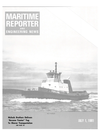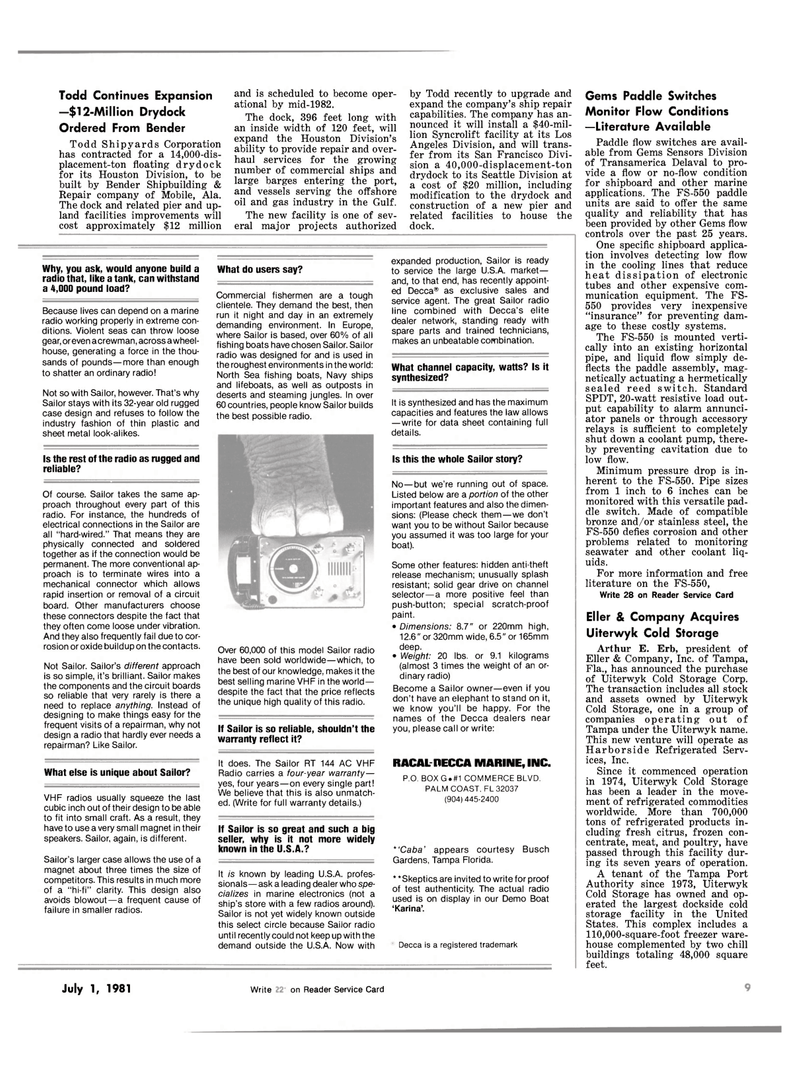
Page 7: of Maritime Reporter Magazine (July 1981)
Read this page in Pdf, Flash or Html5 edition of July 1981 Maritime Reporter Magazine
Todd Continues Expansion —$12-Million Drydock
Ordered From Bender
Todd Shipyards Corporation has contracted for a 14,000-dis- placement-ton floating drydock for its Houston Division, to be built by Bender Shipbuilding &
Repair company of Mobile, Ala.
The dock and related pier and up- land facilities improvements will cost approximately $12 million and is scheduled to become oper- ational by mid-1982.
The dock, 396 feet long with an inside width of 120 feet, will expand the Houston Division's ability to provide repair and over- haul services for the growing number of commercial ships and large barges entering the port, and vessels serving the offshore oil and gas industry in the Gulf.
The new facility is one of sev- eral major projects authorized by Todd recently to upgrade and expand the company's ship repair capabilities. The company has an- nounced it will install a $40-mil- lion Syncrolift facility at its Los
Angeles Division, and will trans- fer from its San Francisco Divi- sion a 40,000-displacement-ton drydock to its Seattle Division at a cost of $20 million, including modification to the drydock and construction of a new pier and related facilities to house the dock.
Why, you ask, would anyone build a radio that, like a tank, can withstand a 4,000 pound load?
Because lives can depend on a marine radio working properly in extreme con- ditions. Violent seas can throw loose gear, or even a crewman, across a wheel- house, generating a force in the thou- sands of pounds—more than enough to shatter an ordinary radio!
Not so with Sailor, however. That's why
Sailor stays with its 32-year old rugged case design and refuses to follow the industry fashion of thin plastic and sheet metal look-alikes.
What do users say?
Commercial fishermen are a tough clientele. They demand the best, then run it night and day in an extremely demanding environment. In Europe, where Sailor is based, over 60% of all fishing boats have chosen Sailor. Sailor radio was designed for and is used in the roughest environments in the world:
North Sea fishing boats, Navy ships and lifeboats, as well as outposts in deserts and steaming jungles. In over 60 countries, people know Sailor builds the best possible radio. expanded production, Sailor is ready to service the large U.S.A. market— and, to that end, has recently appoint- ed Decca® as exclusive sales and service agent. The great Sailor radio line combined with Decca's elite dealer network, standing ready with spare parts and trained technicians, makes an unbeatable combination.
What channel capacity, watts? Is it synthesized?
It is synthesized and has the maximum capacities and features the law allows —write for data sheet containing full details.
Is the rest of the radio as rugged and reliable?
Of course. Sailor takes the same ap- proach throughout every part of this radio. For instance, the hundreds of electrical connections in the Sailor are all "hard-wired." That means they are physically connected and soldered together as if the connection would be permanent. The more conventional ap- proach is to terminate wires into a mechanical connector which allows rapid insertion or removal of a circuit board. Other manufacturers choose these connectors despite the fact that they often come loose under vibration.
And they also frequently fail due to cor- rosion or oxide buildup on the contacts.
Not Sailor. Sailor's different approach is so simple, it's brilliant. Sailor makes the components and the circuit boards so reliable that very rarely is there a need to replace anything. Instead of designing to make things easy for the frequent visits of a repairman, why not design a radio that hardly ever needs a repairman? Like Sailor.
What else is unique about Sailor?
VHF radios usually squeeze the last cubic inch out of their design to be able to fit into small craft. As a result, they have to use a very small magnet in their speakers. Sailor, again, is different.
Sailor's larger case allows the use of a magnet about three times the size of competitors. This results in much more of a "hi-fi" clarity. This design also avoids blowout—a frequent cause of failure in smaller radios.
Over 60,000 of this model Sailor radio have been sold worldwide—which, to the best of our knowledge, makes it the best selling marine VHF in the world — despite the fact that the price reflects the unique high quality of this radio.
If Sailor is so reliable, shouldn't the warranty reflect it?
It does. The Sailor RT 144 AC VHF
Radio carries a four-year warranty— yes, four years—on every single part!
We believe that this is also unmatch- ed. (Write for full warranty details.)
If Sailor is so great and such a big seller, why is it not more widely known in the U.S.A.?
It is known by leading U.S.A. profes- sionals—ask a leading dealer who spe- cializes in marine electronics (not a ship's store with a few radios around).
Sailor is not yet widely known outside this select circle because Sailor radio until recently could not keep up with the demand outside the U.S.A. Now with
Is this the whole Sailor story?
No—but we're running out of space.
Listed below are a portion of the other important features and also the dimen- sions: (Please check them —we don't want you to be without Sailor because you assumed it was too large for your boat).
Some other features: hidden anti-theft release mechanism; unusually splash resistant; solid gear drive on channel selector—a more positive feel than push-button; special scratch-proof paint. • Dimensions: 8.7" or 220mm high, 12.6" or 320mm wide, 6.5" or 165mm deep. • Weight: 20 lbs. or 9.1 kilograms (almost 3 times the weight of an or- dinary radio)
Become a Sailor owner—even if you don't have an elephant to stand on it, we know you'll be happy. For the names of the Decca dealers near you, please call or write:
RACAL-DECCA MARINE, INC.
P.O. BOX G.#1 COMMERCE BLVD.
PALM COAST. FL 32037 (904)445-2400 *'Caba' appears courtesy Busch
Gardens, Tampa Florida. * 'Skeptics are invited to write for proof of test authenticity. The actual radio used is on display in our Demo Boat 'Karina'.
Decca is a registered trademark
Gems Paddle Switches
Monitor Flow Conditions —Literature Available
Paddle flow switches are avail- able from Gems Sensors Division of Transamerica Delaval to pro- vide a flow or no-flow condition for shipboard and other marine applications. The FS-550 paddle units are said to offer the same quality and reliability that has been provided by other Gems flow controls over the past 25 years.
One specific shipboard applica- tion involves detecting low flow in the cooling lines that reduce heat dissipation of electronic tubes and other expensive com- munication equipment. The FS- 550 provides very inexpensive "insurance" for preventing dam- age to these costly systems.
The FS-550 is mounted verti- cally into an existing horizontal pipe, and liquid flow simply de- flects the paddle assembly, mag- netically actuating a hermetically sealed reed switch. Standard
SPDT, 20-watt resistive load out- put capability to alarm annunci- ator panels or through accessory relays is sufficient to completely shut down a coolant pump, there- by preventing cavitation due to low flow.
Minimum pressure drop is in- herent to the FS-550. Pipe sizes from 1 inch to 6 inches can be monitored with this versatile pad- dle switch. Made of compatible bronze and/or stainless steel, the
FS-550 defies corrosion and other problems related to monitoring seawater and other coolant liq- uids.
For more information and free literature on the FS-550,
Write 28 on Reader Service Card
Eller & Company Acquires
Uiterwyk Cold Storage
Arthur E. Erb, president of
Eller & Company, Inc. of Tampa,
Fla., has announced the purchase of Uiterwyk Cold Storage Corp.
The transaction includes all stock and assets owned by Uiterwyk
Cold Storage, one in a group of companies operating out of
Tampa under the Uiterwyk name.
This new venture will operate as
Harborside Refrigerated Serv- ices, Inc.
Since it commenced operation in 1974, Uiterwyk Cold Storage has been a leader in the move- ment of refrigerated commodities worldwide. More than 700,000 tons of refrigerated products in- cluding fresh citrus, frozen con- centrate, meat, and poultry, have passed through this facility dur- ing its seven years of operation.
A tenant of the Tampa Port
Authority since 1973, Uiterwyk
Cold Storage has owned and op- erated the largest dockside cold storage facility in the United
States. This complex includes a 110,000-square-foot freezer ware- house complemented by two chill buildings totaling 48,000 square feet.
July 1, 1981 Write 503 on Reader Service Card 9

 6
6

 8
8
